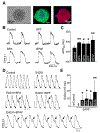Proarrhythmic toxicity of low dose bisphenol A and its analogs in human iPSC-derived cardiomyocytes and human cardiac organoids through delay of cardiac repolarization
- PMID: 37004823
- PMCID: PMC10121900
- DOI: 10.1016/j.chemosphere.2023.138562
Proarrhythmic toxicity of low dose bisphenol A and its analogs in human iPSC-derived cardiomyocytes and human cardiac organoids through delay of cardiac repolarization
Abstract
Bisphenol A (BPA) and its analogs are common environmental chemicals with many potential adverse health effects. The impact of environmentally relevant low dose BPA on human heart, including cardiac electrical properties, is not understood. Perturbation of cardiac electrical properties is a key arrhythmogenic mechanism. In particular, delay of cardiac repolarization can cause ectopic excitation of cardiomyocytes and malignant arrhythmia. This can occur as a result of genetic mutations (i.e., long QT (LQT) syndrome), or cardiotoxicity of drugs and environmental chemicals. To define the impact of low dose BPA on electrical properties of cardiomyocytes in a human-relevant model system, we examined the rapid effects of 1 nM BPA in human induced pluripotent stem cell-derived cardiomyocytes (hiPSC-CMs) using patch-clamp and confocal fluorescence imaging. Acute exposure to BPA delayed repolarization and prolonged action potential duration (APD) in hiPSC-CMs through inhibition of the hERG K+ channel. In nodal-like hiPSC-CMs, BPA acutely increased pacing rate through stimulation of the If pacemaker channel. Existing arrhythmia susceptibility determines the response of hiPSC-CMs to BPA. BPA resulted in modest APD prolongation but no ectopic excitation in baseline condition, while rapidly promoted aberrant excitations and tachycardia-like events in myocytes that had drug-simulated LQT phenotype. In hiPSC-CM-based human cardiac organoids, the effects of BPA on APD and aberrant excitation were shared by its analog chemicals, which are often used in "BPA-free" products, with bisphenol AF having the largest effects. Our results reveal that BPA and its analogs have repolarization delay-associated pro-arrhythmic toxicity in human cardiomyocytes, particularly in myocytes that are prone to arrhythmias. The toxicity of these chemicals depends on existing pathophysiological conditions of the heart, and may be particularly pronounced in susceptible individuals. An individualized approach is needed in risk assessment and protection.
Keywords: Arrhythmia; Bisphenol A; Human cardiac organoid; Human iPSC-CMs; Long QT syndrome.
Copyright © 2023 Elsevier Ltd. All rights reserved.
Conflict of interest statement
Declaration of competing interest The authors declare that they have no known competing financial interests or personal relationships that could have appeared to influence the work reported in this paper.
Figures






Similar articles
-
Toxicity of low dose bisphenols in human iPSC-derived cardiomyocytes and human cardiac organoids - Impact on contractile function and hypertrophy.Chemosphere. 2024 Apr;353:141567. doi: 10.1016/j.chemosphere.2024.141567. Epub 2024 Feb 26. Chemosphere. 2024. PMID: 38417488
-
Acute exposure to low-dose bisphenol A delays cardiac repolarization in female canine heart - Implication for proarrhythmic toxicity in large animals.Food Chem Toxicol. 2023 Feb;172:113589. doi: 10.1016/j.fct.2022.113589. Epub 2022 Dec 28. Food Chem Toxicol. 2023. PMID: 36584932 Free PMC article.
-
Drug screening using a library of human induced pluripotent stem cell-derived cardiomyocytes reveals disease-specific patterns of cardiotoxicity.Circulation. 2013 Apr 23;127(16):1677-91. doi: 10.1161/CIRCULATIONAHA.113.001883. Epub 2013 Mar 21. Circulation. 2013. PMID: 23519760 Free PMC article.
-
Moving beyond the comprehensive in vitro proarrhythmia assay: Use of human-induced pluripotent stem cell-derived cardiomyocytes to assess contractile effects associated with drug-induced structural cardiotoxicity.J Appl Toxicol. 2018 Sep;38(9):1166-1176. doi: 10.1002/jat.3611. Epub 2018 Feb 27. J Appl Toxicol. 2018. PMID: 29484688 Review.
-
Cardiotoxicity Assessment of Drugs Using Human iPS Cell-Derived Cardiomyocytes: Toward Proarrhythmic Risk and Cardio-Oncology.Curr Pharm Biotechnol. 2020;21(9):765-772. doi: 10.2174/1389201020666190628143345. Curr Pharm Biotechnol. 2020. PMID: 31264543 Review.
Cited by
-
The new era of cardiovascular research: revolutionizing cardiovascular research with 3D models in a dish.Med Rev (2021). 2024 Feb 20;4(1):68-85. doi: 10.1515/mr-2023-0059. eCollection 2024 Feb. Med Rev (2021). 2024. PMID: 38515776 Free PMC article. Review.
-
Three-Dimensional iPSC-Based In Vitro Cardiac Models for Biomedical and Pharmaceutical Research Applications.Int J Mol Sci. 2024 Oct 4;25(19):10690. doi: 10.3390/ijms251910690. Int J Mol Sci. 2024. PMID: 39409018 Free PMC article. Review.
-
Addressing Key Questions in Organoid Models: Who, Where, How, and Why?Int J Mol Sci. 2023 Nov 6;24(21):16014. doi: 10.3390/ijms242116014. Int J Mol Sci. 2023. PMID: 37958996 Free PMC article. Review.
-
Comparative cardiotoxicity assessment of bisphenol chemicals and estradiol using human induced pluripotent stem cell-derived cardiomyocytes.Toxicol Sci. 2024 Mar 26;198(2):273-287. doi: 10.1093/toxsci/kfae015. Toxicol Sci. 2024. PMID: 38310357 Free PMC article.
-
Association of same-day urinary phenol levels and cardiac electrical alterations: analysis of the Fernald Community Cohort.Environ Health. 2024 Sep 19;23(1):76. doi: 10.1186/s12940-024-01114-x. Environ Health. 2024. PMID: 39300535 Free PMC article.
References
-
- Bezzina CR, Lahrouchi N, Priori SG, 2015. Genetics of sudden cardiac death. Circ Res 116, 1919–1936. - PubMed
-
- Cai S, Rao X, Ye J, Ling Y, Mi S, Chen H, Fan C, Li Y, 2020. Relationship between urinary bisphenol a levels and cardiovascular diseases in the U.S. adult population, 2003-2014. Ecotoxicol Environ Saf 192, 110300. - PubMed
MeSH terms
Substances
Grants and funding
LinkOut - more resources
Full Text Sources

